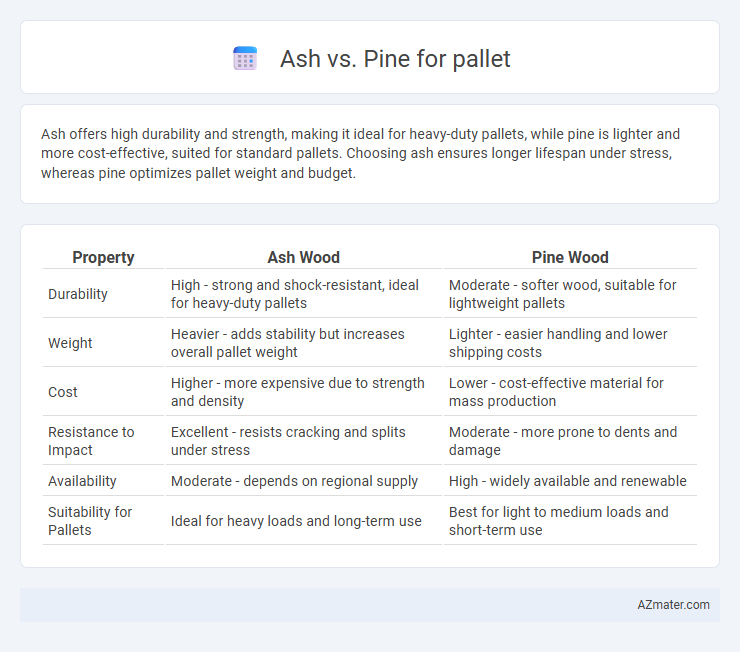Ash offers high durability and strength, making it ideal for heavy-duty pallets, while pine is lighter and more cost-effective, suited for standard pallets. Choosing ash ensures longer lifespan under stress, whereas pine optimizes pallet weight and budget.
Table of Comparison
| Property | Ash Wood | Pine Wood |
|---|---|---|
| Durability | High - strong and shock-resistant, ideal for heavy-duty pallets | Moderate - softer wood, suitable for lightweight pallets |
| Weight | Heavier - adds stability but increases overall pallet weight | Lighter - easier handling and lower shipping costs |
| Cost | Higher - more expensive due to strength and density | Lower - cost-effective material for mass production |
| Resistance to Impact | Excellent - resists cracking and splits under stress | Moderate - more prone to dents and damage |
| Availability | Moderate - depends on regional supply | High - widely available and renewable |
| Suitability for Pallets | Ideal for heavy loads and long-term use | Best for light to medium loads and short-term use |
Overview: Ash vs Pine for Pallets
Ash wood offers superior strength and durability compared to pine, making it ideal for heavy-duty pallets subjected to frequent handling or heavy loads. Pine is lighter, more cost-effective, and easier to work with, making it a popular choice for pallets used in less demanding environments or single-use applications. The choice between ash and pine pallets depends on balancing durability requirements with budget constraints and application-specific needs.
Wood Characteristics: Strength and Durability
Ash wood offers superior strength and shock resistance compared to pine, making it ideal for heavy-duty pallets requiring durability under stress. Pine, being softer and less dense, provides lighter pallets suitable for moderate loads and easier handling. The natural hardness and abrasion resistance of ash contribute to longer pallet lifespan in demanding industrial environments.
Cost Comparison: Ash Pallets vs Pine Pallets
Ash pallets generally cost more than pine pallets due to the wood's higher density and durability, which extends the pallet's lifespan and reduces replacement frequency. Pine pallets are more affordable upfront because pine is a softer wood, widely available and faster growing, making it less expensive to harvest and process. Choosing between ash and pine involves balancing initial investment with long-term savings, where ash offers better value in heavy-duty or long-term applications despite the higher initial cost.
Weight Differences and Handling
Ash pallets are significantly heavier than pine pallets, with ash averaging around 45-50 pounds per standard pallet compared to pine's lighter 30-35 pounds. The increased weight of ash contributes to greater durability and resistance to impact, making it suitable for heavier loads but potentially more challenging to handle manually. Pine pallets offer easier maneuverability due to their lighter weight, which can reduce worker fatigue and improve efficiency in fast-paced warehousing environments.
Sustainability and Environmental Impact
Ash wood is highly sustainable for pallets due to its rapid growth rate and widespread availability, resulting in less deforestation pressure. Pine pallets, while also renewable, often involve faster plantation cycles but can contribute to monoculture practices impacting biodiversity negatively. Both woods can be recycled and biodegrade naturally, but ash offers higher durability, reducing the frequency of pallet replacement and overall environmental footprint.
Workability and Processing
Ash offers excellent workability for pallet manufacturing due to its straight grain and moderate density, allowing easy machining and nailing without splitting. Pine, being softer and less dense, processes faster and requires less tool wear, making it cost-effective for high-volume pallet production. Both woods absorb finishes well, but Ash's durability and resistance to wear make it preferable for pallets subject to heavy use.
Resistance to Pests and Decay
Ash wood exhibits moderate resistance to pests and decay, making it suitable for indoor pallets but requiring protective treatments for outdoor use. Pine is more susceptible to pests like termites and decay, necessitating chemical treatment or pressure treatment to enhance its durability. Choosing ash over pine improves the longevity of pallets exposed to moisture and insect activity, reducing maintenance costs and replacement frequency.
Common Uses in Various Industries
Ash pallets, prized for their strength and shock resistance, are commonly used in the automotive and heavy machinery industries where durable support for transporting heavy parts is essential. Pine pallets, valued for being lightweight and cost-effective, dominate in the food and retail sectors, facilitating easy handling and efficient storage of goods. Both wood types offer industry-specific advantages that optimize logistics and supply chain operations across manufacturing and distribution environments.
Lifespan and Maintenance of Pallets
Ash pallets offer superior lifespan due to their dense, shock-resistant wood, lasting significantly longer under heavy loads compared to pine pallets, which are softer and more prone to damage. Maintenance for ash pallets is minimal, as their durable structure resists splintering and wear, reducing repair frequency and overall costs. Pine pallets require more frequent inspections and repairs to address cracking and breakage, impacting downtime and increasing long-term maintenance expenses.
Choosing the Right Wood: Ash or Pine?
Ash offers superior strength and durability, making it ideal for heavy-duty pallets requiring high load-bearing capacity and resistance to impact. Pine, being lighter and more cost-effective, suits pallets for lighter loads and short-term use, providing good shock absorption and easier handling. Selecting Ash or Pine hinges on the pallet's required strength, longevity, and budget constraints to maximize performance and cost-efficiency.

Infographic: Ash vs Pine for Pallet
 azmater.com
azmater.com